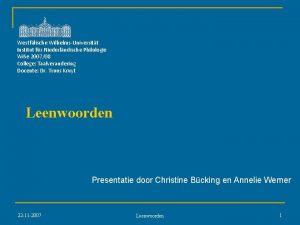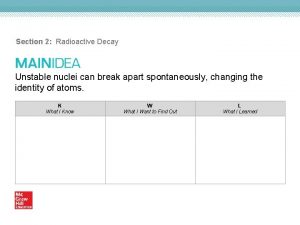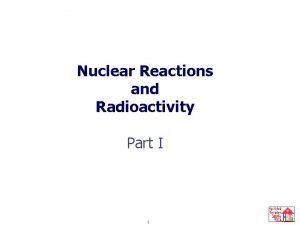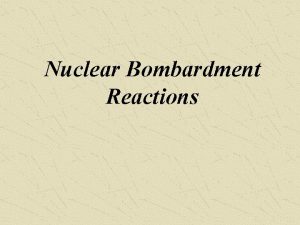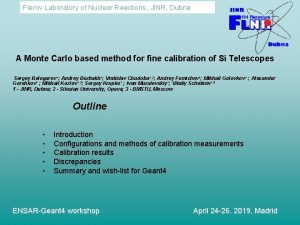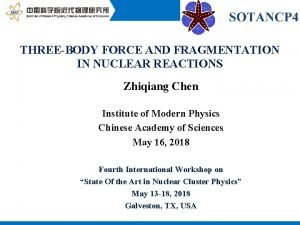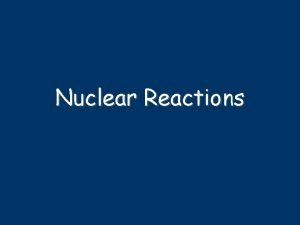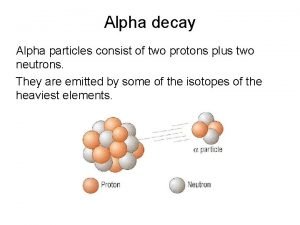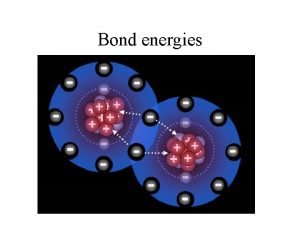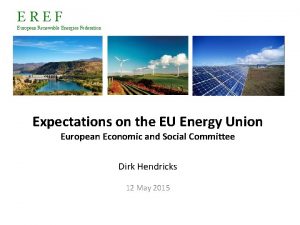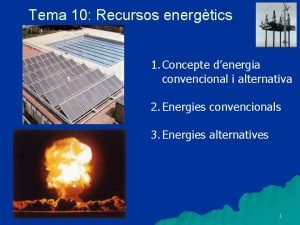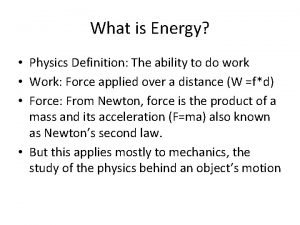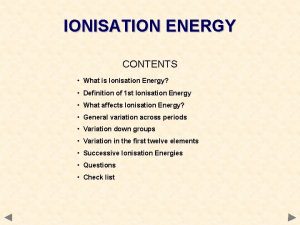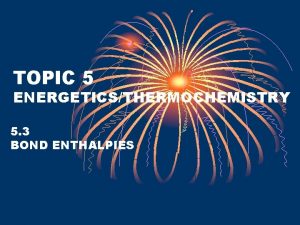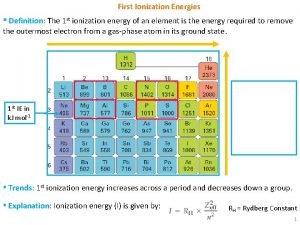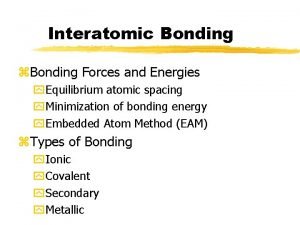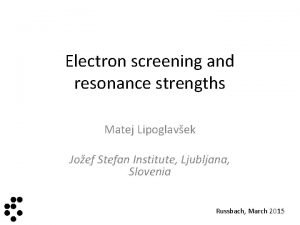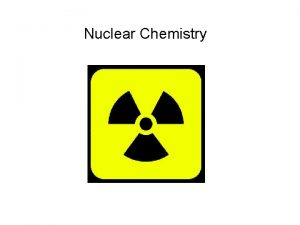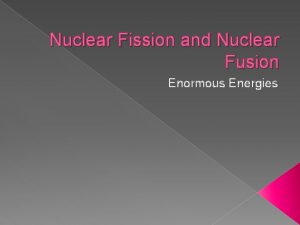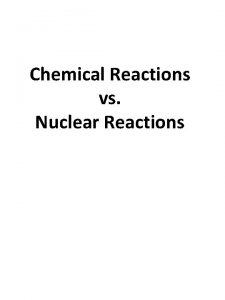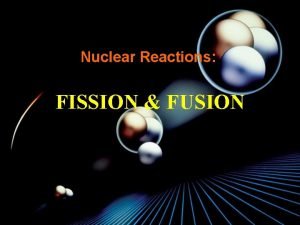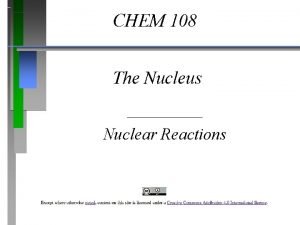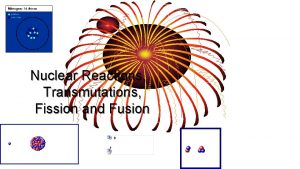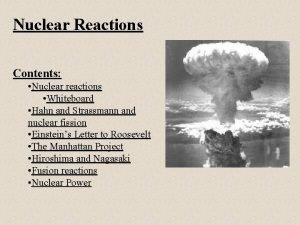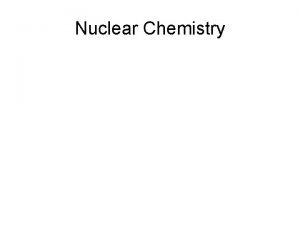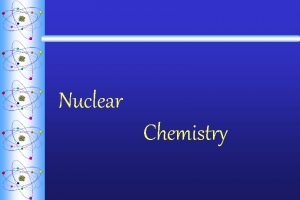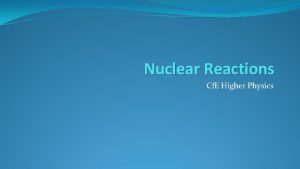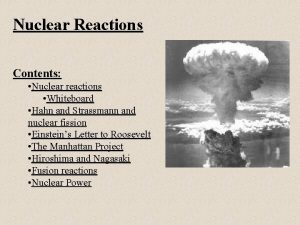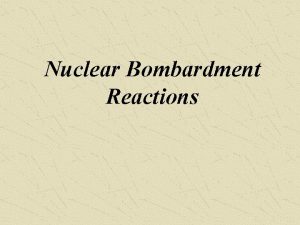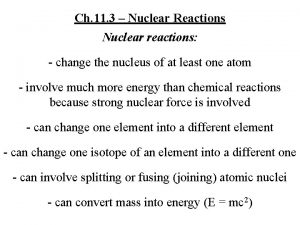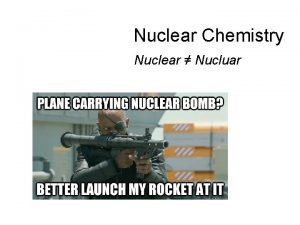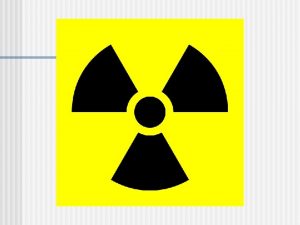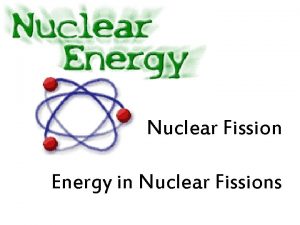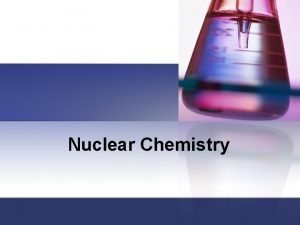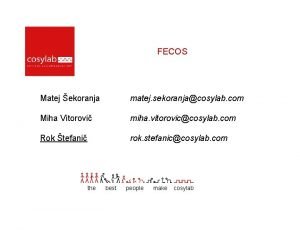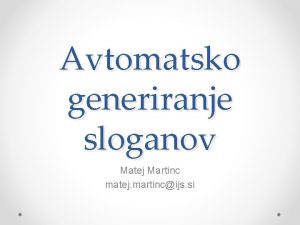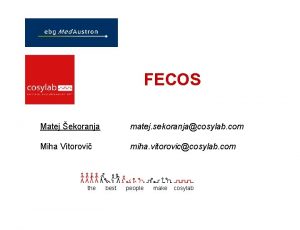Nuclear Reactions at Low Energies Matej Lipoglavek Joef


![Reaction cross section C. M. S. Energy [Me. V] A. Coc, E. Vangioni Int. Reaction cross section C. M. S. Energy [Me. V] A. Coc, E. Vangioni Int.](https://slidetodoc.com/presentation_image_h/05a1db07c32600a0b42cce3d1ea450fd/image-3.jpg)


















![Thick targets 1 H(7 Li, α)4 He Target Ue [ke. V] Stoichiometry Graphite 10. Thick targets 1 H(7 Li, α)4 He Target Ue [ke. V] Stoichiometry Graphite 10.](https://slidetodoc.com/presentation_image_h/05a1db07c32600a0b42cce3d1ea450fd/image-22.jpg)




![Results Target Reaction Ue [ke. V] 7 Li+p 11 B+p 19 F+p adiabatic 0. Results Target Reaction Ue [ke. V] 7 Li+p 11 B+p 19 F+p adiabatic 0.](https://slidetodoc.com/presentation_image_h/05a1db07c32600a0b42cce3d1ea450fd/image-27.jpg)





- Slides: 32

Nuclear Reactions at Low Energies Matej Lipoglavšek Jožef Stefan Institute, Ljubljana, Slovenia Russbach, March 2019

BBN reaction network 7 Be 1 2 1 1 3 He 7 Li 9 4 He 8 4 5 1 H 1 1 n 2 2 d 7 6 3 1 0 3 t Reactions important for the production of the lightest elements (B. D. Fields, Annual Reviews of Nuclear and Particle Science 61, 2011)
![Reaction cross section C M S Energy Me V A Coc E Vangioni Int Reaction cross section C. M. S. Energy [Me. V] A. Coc, E. Vangioni Int.](https://slidetodoc.com/presentation_image_h/05a1db07c32600a0b42cce3d1ea450fd/image-3.jpg)
Reaction cross section C. M. S. Energy [Me. V] A. Coc, E. Vangioni Int. J. Mod. Phys. E 26, 1741002 (2017)

Measurements @ JSI 2 MV Tandem van de Graaf accelerator

Implanted deuterium targets Deuterium implanted into graphite or titanium at 3. 5 k. V resulting in about 10 at. % deuterium concentration. Proton beam energy between 260 and 300 ke. V from the 2 MV Tandetron accelerator.

Cross section results Differential cross section at θ = 135˚ y r a n i P r m i l e

Angular Distribution L. Marcucci et al. , PRL 116, 102501 (2016)

S-factor Sommerfeld parameter:

Electron detection Detecting electrons with ΔE – E technique beam current Ge detector graphite target beam Si detector Cs. I detector

Bi-207 source

Electrons 2 H(p, γ)3 He 2 H(p, e-)3 He

Results Beam energy at half target thickness: 243 ke. V Cross section: 2 H(p, γ)3 He, σ=1. 0(2) μb 2 H(p, e-)3 He, σ=0. 3(1) nb Our We can only say that in at least 7% of the screened reactions an electron is emitted instead of a γ ray.

Catalysis of nuclear reactions by muons Instead of 2 H(p, γ)3 He Alvarez measured 2 H(p, μ)3 He

Electron Screening where Ue is the screeening potential. electron cloud Ec Ue=Z 1 Z 2 e 2/4 pe 0 Ra Potential V(r) Cross section increases at low energies when the interacting nuclei are not bare. Enhancement factor E + Ue = Eeff 0 Rn nuclear radius Ra Bohr radius r H. J. Assenbaum, K. Langanke and C. Rolfs, Z. Phys. A 327 (1987) 461. 305 citations (Web of Science, March 2016).

Previous Results 1 for d(d, p)t reaction from F. Raiola et al. , Eur. Phys. J. A 19 (2004) 283.

Previous Results 2 J. Kasagi, Prog. Theo. Phys. Suppl. 154 (2004) 365. for the d(d, p)t reaction Ue=310± 30 e. V @ 7% H/Pd => concentration dependence

Previous Results 3 for d(d, p)t reaction from K. Czerski et al. , J. Phys. G 35 (2008) 014012. for zirconium metal Ue=319± 3 e. V

Previous Results 4 J. Cruz et al. , Phys. Lett. B 624 (2005) 181; J. Phys. G 35 (2008) 014004. Pd. Li 1%: Ue= 3. 7 ± 0. 3 ke. V Li metal: Ue= 1. 18 ± 0. 06 ke. V -77 e. V Li 2 WO 4: Ue= 237+133 S(E)=0. 055+0. 21 E-0. 31 E 2[Me. V b]

Previous Results 5 L. Lamia et al. , Astron. Astrophys. 541, A 158 (2012). Trojan horse method → bare S factor S(E)=0. 053+0. 213 E-0. 336 E 2[Me. V b] 7 Li(p, α)4 He reaction Ue= 425 ± 60 e. V in Li metal Adiabatic limit: Ue= 240 e. V

Measurements @ JSI X-ray detector beam current target beam Pb absorber neutron detector Ge detector

Comparison to previous results Target Stoichiometry 7 Li+p d+d Ni 0. 04 0. 13 Zn 0. 68 0. 13 Pd 0. 296 0. 03 Pt 0. 24 0. 06 Reaction Ue [ke. V] Target 7 Li+p p+7 Li d+d F. Raiola et al. , Eur. Phys. J. A 19 (2004) 283. Ni 4. 1 ± 1. 0 0. 38 ± 0. 04 p+7 Li J. Cruz et al. , Phys. Lett. B 624 (2005) 181. Zn 2. 4 ± 1. 0 0. 48 ± 0. 05 7 Li+p J. Vesic et al. , Eur. Phys. J. A 50 (2014) 153. Pd 2. 3 ± 0. 5 3. 7 ± 0. 3 0. 80 ± 0. 09 Pt 2. 8 ± 1. 3 0. 67 ± 0. 05
![Thick targets 1 H7 Li α4 He Target Ue ke V Stoichiometry Graphite 10 Thick targets 1 H(7 Li, α)4 He Target Ue [ke. V] Stoichiometry Graphite 10.](https://slidetodoc.com/presentation_image_h/05a1db07c32600a0b42cce3d1ea450fd/image-22.jpg)
Thick targets 1 H(7 Li, α)4 He Target Ue [ke. V] Stoichiometry Graphite 10. 3 ± 0. 4 0. 059± 0. 003 Pd 3. 6 ± 0. 7 0. 21± 0. 01 Ti. H 3. 9 ± 0. 4 1. 03± 0. 04 W 5. 9 ± 0. 9 0. 042± 0. 003 Adiabatic limit: Ue= 0. 24 ke. V

Thin targets and resonances Breit Wigner resonance cross section Infinitely thick target yield of narrow resonance Integral over the resonance C. Iliadis, Nuclear Physics of Stars, Wiley-VCH, Weinheim, (2007) p. 341.

The 19 F(p, αγ)16 O reaction K. Spyrou et al. , Z. Phys. A 357 (1997) 283; Eur. Phys. J. A 7 (2000) 79.

Fluorine results A. Cvetinović, Ph. D Thesis, University of Ljubljana (2015).

The 11 B(p, αα)4 He reaction H. W. Becker et al. , Z. Phys. , A 327, 341 (1987).
![Results Target Reaction Ue ke V 7 Lip 11 Bp 19 Fp adiabatic 0 Results Target Reaction Ue [ke. V] 7 Li+p 11 B+p 19 F+p adiabatic 0.](https://slidetodoc.com/presentation_image_h/05a1db07c32600a0b42cce3d1ea450fd/image-27.jpg)
Results Target Reaction Ue [ke. V] 7 Li+p 11 B+p 19 F+p adiabatic 0. 24 0. 68 2. 19 Graphite 10. 3 ± 0. 4 32 ± 4 115 ± 8 Pd 3. 6 ± 0. 7 8. 0 ± 1. 9 63 ± 6 Ti. H 3. 9 ± 0. 4 6. 7 ± 1. 8 62 ± 6 W 5. 9 ± 0. 9 - 75 ± 15 Graphite/ adiabatic 42. 9 ± 1. 7 47. 1 ± 5. 9 52. 5 ± 3. 6 A. Cvetinović, Phys. Rev. C 92 (2015) 065801.

Crystal symmetry small screening large screening fcc (Pd) Hexagonal Graphite

Hydrogen molecular ion

Hydrogen molecular ion

Measurement setup In addition to 2 H(p, γ)3 He we looked for electrons from the 2 H(p, e-)3 He reaction Proton beam energy: 260 ke. V, intensity: 7 μA, 8 days Target: graphite implanted with deuterium at 3 ke. V once a day for ½ hour at 0. 8 m. A resulted in 8 at. % of deuterium per carbon atom down to a depth of about 270 nm Cs. I-Si timestamped Expectations:

Conclusions • During the electron screening process the electrons come close to the nucleus. • A substantial number of fusion reactions in the Sun proceeds with electron emission. • Electron screening could help in lithium abundance problem. • Different screening potentials are due to different proportions of target nuclei on active and inactive sites. • For stellar plasma we really need to understand what happens in the laboratory experiments.
 Lesson 15 nuclear quest nuclear reactions
Lesson 15 nuclear quest nuclear reactions Joef betekenis
Joef betekenis Fisión nuclear vs fision nuclear
Fisión nuclear vs fision nuclear Key terms radioactivity and nuclear reactions
Key terms radioactivity and nuclear reactions Balancing nuclear reactions
Balancing nuclear reactions Two types of nuclear reactions
Two types of nuclear reactions Nuclear decays and reactions section 2
Nuclear decays and reactions section 2 Balancing nuclear reactions
Balancing nuclear reactions Bombardment reactions
Bombardment reactions U 235 fission products
U 235 fission products Flerov laboratory of nuclear reactions
Flerov laboratory of nuclear reactions Nuclear reactions are at
Nuclear reactions are at Artificial transmutation
Artificial transmutation Alpha decay of uranium 238
Alpha decay of uranium 238 Unit 5 chemical reactions answers
Unit 5 chemical reactions answers Oxidation half reaction
Oxidation half reaction Section 2 classifying chemical reactions worksheet answers
Section 2 classifying chemical reactions worksheet answers Chemical reactions section 2 classifying chemical reactions
Chemical reactions section 2 classifying chemical reactions Types of reactions
Types of reactions Low voltage hazards
Low voltage hazards Mid low high
Mid low high Emotive style communication
Emotive style communication Low accuracy low precision
Low accuracy low precision Is bond breaking endothermic
Is bond breaking endothermic European renewable energies federation
European renewable energies federation Four energies
Four energies Ganggalion
Ganggalion Energies convencionals
Energies convencionals Energy definition physics
Energy definition physics Successive ionisation energies of calcium
Successive ionisation energies of calcium Bond enthalpy reactants minus products
Bond enthalpy reactants minus products First ionization energy definition
First ionization energy definition Bonding force and energy
Bonding force and energy

